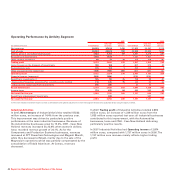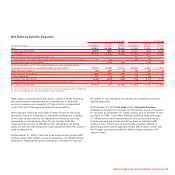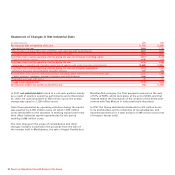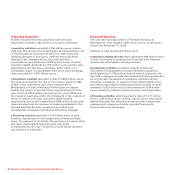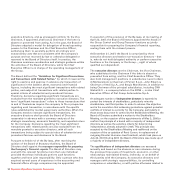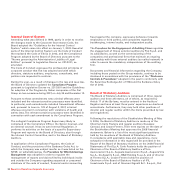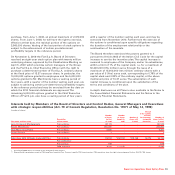Chrysler 2007 Annual Report Download - page 55
Download and view the complete annual report
Please find page 55 of the 2007 Chrysler annual report below. You can navigate through the pages in the report by either clicking on the pages listed below, or by using the keyword search tool below to find specific information within the annual report.Report on Operations Corporate Governance54
executive directors, and as envisaged in Article 12, the Vice
Chairman, if appointed, shall act as Chairman if the latter is
absent or prevented from acting. As in the past, the Board of
Directors adopted a model for delegation of broad operating
powers to the Chairman and the Chief Executive Officer,
authorising them to severally perform all ordinary and
extraordinary acts that are consistent with the Company’s
purpose and not reserved by law or otherwise delegated or
reserved to the Board of Directors itself. In practice, the
Chairman exercises coordination and strategic guidance within
the activities of the Board of Directors, while the Chief
Executive Officer is in charge of the operating management of
the Group.
The Board defined the “Guidelines for Significant Transactions
and Transactions with Related Parties,” by which it reserved the
right to examine and approve in advance any transaction of
significance in the balance sheet, economic and financial
figures, including the most significant transactions with related
parties, and subject all transactions with related parties to
special criteria of substantial and procedural fairness.
Therefore, decisions regarding significant transactions are
excluded from the mandate granted to executive directors. The
term “significant transactions” refers to those transactions that
in and of themselves require the company to file a prospectus
regarding such transaction, in accordance with the specific
rules established by market supervisory authorities. When the
Company needs to execute significant transactions, the
executive directors shall provide the Board of Directors
reasonably in advance with a summary analysis of the
strategic consistency, economic feasibility, and expected return
for the Company. Decisions regarding the most significant
transactions with related parties are also excluded from the
mandate granted to executive directors, with all such
transactions being subject to special rules of substantial and
procedural fairness and disclosure to the Board.
Pursuant to Article 12 of the By-laws, after receiving the
opinion of the Board of Statutory Auditors, the Board of
Directors shall appoint the manager responsible for preparing
the Company’s financial reports. The Board of Directors may
vest with the relevant functions more than one individual
provided that these individuals perform such functions
together and have joint responsibility. Only a person who has
acquired several years of experience in the accounting and
financial affairs at large companies may be appointed.
In execution of this provision of the By-laws, at its meeting of
April 23, 2007, the Board of Directors appointed the heads of
the Group Control and Group Treasury functions as jointly
responsible for preparing the Company’s financial reporting,
vesting them with the relevant powers.
At December 31, 2007, the Board is comprised by three
executive directors and twelve non-executive directors – that
is, who do not hold delegated authority or perform executive
functions in the Company or the Group –, eight of whom
qualified as independent.
The executive directors are the Chairman, the Vice Chairman,
who substitutes for the Chairman if the latter is absent or
prevented from acting, and the Chief Executive Officer. They
also hold management positions in subsidiaries: Luca Cordero
di Montezemolo is Chairman of Ferrari S.p.A., John Elkann is
Chairman of Itedi S.p.A., and Sergio Marchionne, in addition to
being Chairman of the principal subsidiaries, including CNH
Global N.V. – a company listed on the NYSE –, is also Chief
Executive Officer of Fiat Group Automobiles S.p.A.
An adequate number of independent directors is essential to
protect the interests of stockholders, particularly minority
stockholders, and third parties. In order to achieve this objective
and in the conviction that enhancing protections against potential
conflicts of interest is a priority for the Company, particularly in
those areas less prone to control by the Stockholders Meeting, the
Board of Directors submitted a motion to the Stockholders
Meeting, on the occasion of the appointments of May 3, 2006,to
confirm the principle of a board with a majority of independent
directors as well as the selective criteria for determining
independence, already adopted in 2005. This principle was
accepted by the Stockholders Meeting and reaffirmed on the
occasion of the co-optation of René Carron, in replacement of
resigning Director Hermann-Josef Lamberti, which took place on
July 24, 2007. During 2007, the Board of Directors was made up of
a majority of independent directors.
The qualifications of independent directors are assessed
annually and based on the absence or non relevance during
the previous three years of investment, economic, or other
relationships maintained directly, indirectly, or on behalf of
third parties with the Company, its executive directors and
managers with strategic responsibilities, its controlling
companies or subsidiaries, or with parties otherwise related to




